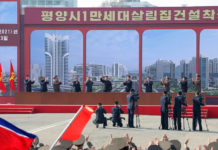Beginning in the late 1950s, Japan offered to help repatriate the Zainichi, many of whom were attracted to North Korea’s socialist promises and an economy then larger than the South’s. Nearly 100,000 people moved, including Mr. Oshima’s parents and siblings.
Mr. Oshima, 20 at the time, had intended to follow them, and was just waiting for word from his family.
To circumvent censors, they used code. If they wrote in vertical script, as is typical in Japanese, it meant Mr. Oshima should join them. But if the writing was horizontal, that would be a warning to stay away.
When the first letters arrived, the words marched across the page, left to right.
‘Big Island’
Mr. Oshima’s parents set sail from a village in southeastern Korea in 1934, searching for work as Japan’s war machine was warming up.
They settled in a small town in southern Japan and raised five children. Mr. Oshima’s father supported them by chopping wood and selling charcoal. To disguise their heritage, they adopted a Japanese surname, which meant “big island.”
Mr. Oshima recalled that classmates taunted them, asking, “Are Koreans actually human beings?”
Discrimination was baked into the laws, which made it difficult for Zainichi to become citizens. Mr. Oshima hoped to study engineering but was barred from a specialized high school and ended up teaching at a Korean school.
Most of his first pupils were from families preparing to move to the North.
At the time, in the late 1950s, Japanese officials were quietly working with Pyongyang on a repatriation program.
Source : Nytimes











